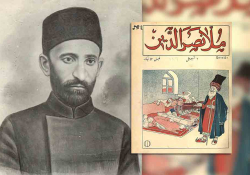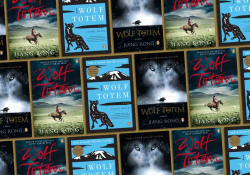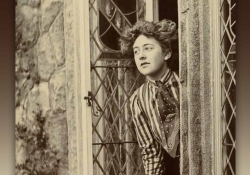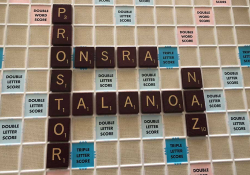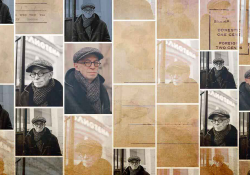Weighers of Pearls
The image is central to most poets and poetry. In Elizabeth Bishop’s poem “The Fish,” the image is the poem. “His brown skin hung in strips / like ancient wallpaper, / and its pattern of darker brown / was like wallpaper: / shapes like full-blown roses / stained and lost through age.” But not every image is a heavy fish the poet caught herself; sometimes the poem is drawn not directly from the world, but from another work of art. Then it becomes ekphrastic poetry. Like Keats’s “Ode on a Grecian Urn,” the poem becomes a meditation on a different form of art. Sometimes a single work of art catches the eye of more than one poet: W. H. Auden in his “Musée des Beaux Arts” and William Carlos Williams in his “Landscape with the Fall of Icarus” were both drawn to Bruegel’s treatment of the death of Icarus as almost insignificant, a tiny event behind a farmer plowing his field.
Sometimes the relation between the art and the artist is closer than a visit to a museum. In the 1920s and ’30s, surrealism and futurism were movements of both artists and writers. In the 1950s and ’60s, the New York School combined visual art, dance, theater, and writing and included the painters Jackson Pollock and Willem de Kooning as well as the poets Kenneth Koch and John Ashbery. The special art poetry section in the November 2015 issue of World Literature Today features ekphrastic texts by poets from around the world and shows how lively and widely practiced the form is today.
The art poetry section includes poems by two Uruguayan poets I translate: “Suddenly there is the horse,” by Tatiana Oroño, about an etched gourd created by her father, Dumas Oroño, a well-known Uruguayan artist; and two poems by Circe Maia, including one about a work by another Uruguayan artist, “On a Painting by Cuneo.” Uruguay is a small country, and poets and artists tend to know one another in the same way most Uruguayans know one another, through a shared culture and a web of friendships and family connections. Since Tatiana Oroño’s father was an artist, she has always been involved with artists, writing often about art, in poetry and prose. Circe Maia’s parents were art lovers and friends of Dumas Oroño, who often visited their house when Circe was little. Indeed, for the cover art for the collection I edited and translated entitledThe Invisible Bridge / El puente invisible: Selected Poems of Circe Maia (University of Pittsburgh Press, 2015), Circe Maia chose a painting by Dumas Oroño. But Tatiana Oroño and Circe Maia live about as far from each other (Tacuarembó is a five-hour drive from Montevideo) as possible in so small a country—their connections to each other, like so many poets, is through their poems and their love of art.
One day in 2012, on a bus in Montevideo, Tatiana Oroño opened Pesadora de perlas (Weigher of pearls), an edition of poems by Circe Maia that had just been published in Argentina by the Viento de Fondo. Inside, she saw a photograph that Gastón Sironi, the editor of the press, had taken of Circe in her house in Tacuarembó.
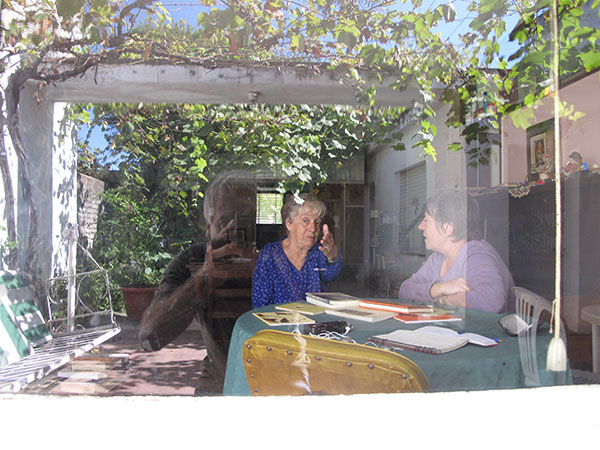
It is a striking photo. Circe Maia, in a blue blouse, sits inside her house at a round table covered with books. She is in conversation with a woman, María Teresa Adruetto, whose interview with Circe also appears in La Pesadora de perlas. Behind Circe, you can see the interior of her house, an upright piano, the dining room table. You can even see a window with venetian blinds that looks out onto the green trees in the street beyond. I know the house well, and the window is in what was once the medical office of Circe’s husband, Ariel, a retired doctor, a room that now serves as Circe’s study.
But the photo is more complex than that. There is a sliding glass door between Circe, who raises her hand and points directly at the viewer, and Gastón Sironi, camera in hand. He is reflected in the photo, as is the grape arbor, hanging bench, and trees of Circe’s back garden. This compressed image, with no longer a clear division between inner and outer worlds, sent Tatiana home to write this poem:
circe maia
Tatiana Oroño
and teresa andruetto – fall 2012 – conversing
for viento de fondo
I leaf through it on the bus – September 2013 – / at home again pick up la pesadora de perlas.
the weigher of pearls
the weight of paper is a fruit skin, the hand slides, discovers
each line of dialogue awakes connects eyes and page
the magic of a photo captures /
straight
a gesture the glance follows
Circe’s hand waving toward the garden (grape arbor in time
of harvest sun): foliage chiaroscuro, wall, mirror-like
join/separate
The table of the house where they converse, upholstered in books and all reflected in the glass
through which
the camera
shoots/captures
the light of the other side (the front window reflecting
foliage of the street): the interior brimming
with words and images traveling
inside/out. behind the photograph
by gastón sironi, on following pages
the slight weight
of the pearls shines through
the pearls the two women
weigh with their inner light
their shared tongue
But like the doubled images in the photograph, behind this poem by Tatiana Oroño lies another poem, “La pesadora de perlas,” by Circe Maia. “La pesadora de perlas” is also an ekphrastic poem, one about the Dutch painter Johannes Vermeer’s painting known in Spanish as La pesadora de perlas, the weigher of pearls, usually called in English Woman with a Balance.
As a painter, Vermeer is famous for his renderings of women and for the play of light and shadow in his works.
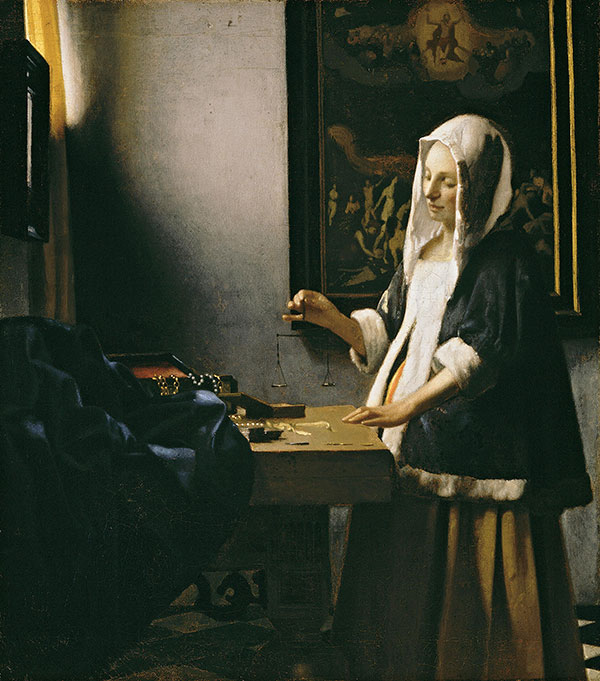
“La pesadora de perlas” is the last of six connected poems about Vermeer from Circe Maia’s book Cambios, Permanencias.
VI
( La pesadora de perlas)
The most delicate object supported
delicately as well:
small balance for pearls.
In the air, it’s immobile.
Perfect equilibrium: the hand supports it
the eyes support it
air-light holds it up.
Look at it.
Or better you don’t look
we don’t look
an opaque eye could possibly –
don’t you think?
Tip it.
As a painter, Vermeer is famous for his renderings of women and for the play of light and shadow in his works. Looking at the images together, the portrait of Circe Maia by Gastón Sironi and La pesadora de perlas / Woman with a Balance by Vermeer, you cannot help but see similarities and strong visual connections. Add to that the two poems, “circe maia” by Tatiana Oroño and “La pesadora de perlas” by Circe Maia, and you find yourself in the middle of a lively conversation between two poets and two artists that reaches across space and time.
Madison, Wisconsin
Translations from the Spanish
By Jesse Lee Kercheval

